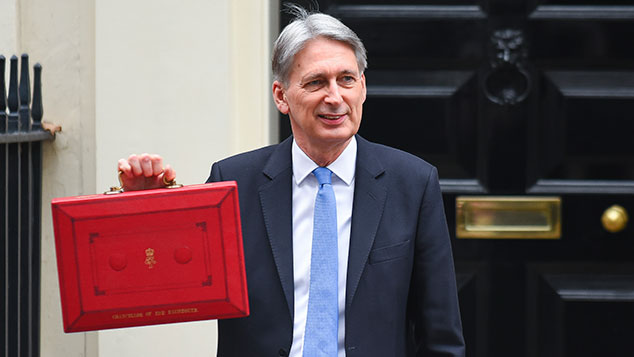
Looking at the headlines this morning, the Budget clearly hasn’t gone too badly.
For a start, Phil Hammond is still the chancellor this morning. For another thing, the headlines are largely begrudging “best of a bad job” takes, with no obvious clangers – so at least we probably won’t be seeing any U-turns before the end of the week.
So what transpired, and what does it all mean for you?
Take all forecasts with a skip-full of salt
The most eye-catching aspect of the budget is probably also the least consequential. Britain saw its growth prospects suffer a massive downgrade. This is because productivity (output per hour) growth remains very poor, and the Office for Budget Responsibility (OBR) has only just accepted that it’s not returning to the pre-2008 trend particularly quickly.
That means growth is lower, and therefore, tax receipts will be lower, and therefore the government’s finances will be even more of a mess.
This all looks bad on paper, but inconveniently, you can’t really rely on these forecasts. The reason things now look so bad is because the OBR has previously been so wrong. So the jury’s out on whether its new estimates will be any more accurate.
(Just to give you a minor “behind-the-scenes” view on how scientific these things are, I just glanced through my inbox. One high-profile economic research consultancy says it thinks the OBR is still too optimistic; another email from an equally high-profile economic research consultancy thinks they’re too pessimistic. These guys all recruit from the same pool of PhDs, so take your pick according to your political preferences.)
Anyway, the market couldn’t care less. The pound had a pretty decent day yesterday (it rarely reacts to Budgets these days). So let’s just see how it all pans out over time.
The house price crisis continues
The other big theme of the day was property.
I’m not going to unpack this here (there’s not enough space), but the prevailing argument about the housing market in the UK is that the problem is all about supply. There aren’t enough houses. That’s why prices are so high.
I’d argue – and long have done – that the problem isn’t that there aren’t enough houses, it’s that there’s too much money available to spend on them. It’s more about credit than about physical quantities of property.
And beyond that, there are much bigger, more complicated structural issues surrounding land ownership and the lack of innovation in building.
Anyway, none of that was tackled yesterday, as you’d expect.
A big stamp duty gimmick was announced. If you’re a first-time buyer, you will pay no stamp duty on properties up to £300,000; and no duty on the first £300,000 if you’re buying a property worth up to £500,000.
Thus, the various layers of stamp duty are becoming ever more complicated. It used to be one buyer, one rate. Now, a £300,000 house purchase carries three different stamp duty bills, depending on whether you are a) a first-time buyer; b) a homeowner who is moving; or c) a buy-to-let landlord.
Why don’t we go the whole hog and throw a surcharge for income tax band in there as well? No wonder our tax code is so long.
It’s not going to help with house prices. The majority of the cut will just end up being added to sales prices. In other words, house prices will just go higher because people now have more to spend.
Even so, it will no doubt please anyone who gets to benefit from it. The main point of a stamp duty cut is not to make houses cheaper, but to reduce the upfront costs of “getting on the ladder”.
Let’s say you’re buying a house for £295,000 with a 10% deposit. At the start of the week, you’d have had to pay £4,750 in stamp duty. So that means you need £34,250 just to move (the £29,500 deposit plus stamp duty, excluding all the conveyancing fees and other moving costs).
Now, let’s say that the whole of the stamp duty holiday accrues to the seller. So the price of the house goes up to £299,750. Your upfront cost is still significantly lower – £29,975.
On top of that, as my colleague Merryn has pointed out, a buy-to-let hopeful would still have to pay £13,600 in stamp duty to buy the same house (£4,750 normal stamp duty, plus the 3% surcharge).
Building more houses
So from that point of view, it does help first-time buyers. But it doesn’t do anything about the problem, which is that prices are too high in the first place.
For that, the chancellor is staking his hopes on a combination of incentives for smaller housebuilders (to compete with the big players); more training for construction staff; and steps towards planning reform. But most of this will be outlined a review that will be discussed in the Spring Statement, so really, this is a little bit “jam tomorrow”, in that we don’t know what the practical measures involved will be.
At least he didn’t mess about with pensions and Isas
Finally, pension tax relief and indeed, pensions in general, went unchanged. Clearly, the idea of fiddling even more with our retirement plans is not something the chancellor has the stomach for right now, particularly when it could all go badly wrong in the headlines.
Let’s be grateful for small mercies. We’ll have more on the details of the budget in next week’s issue of MoneyWeek magazine.
If you’re not already a subscriber, get your first four issues free here [LINK].